Evaluating the Socio-Economic Benefits of Tourism in Sri Lanka
VerifiedAdded on 2023/06/13
|54
|12679
|462
Report
AI Summary
This assignment examines the socio-economic impact of tourism on Sri Lanka, focusing on its contribution to GDP, poverty alleviation, transportation development, and job creation. It references the "Mahinda Chinthana" program, which identifies tourism as a key driver of socio-economic development, aiming to increase tourist arrivals and foreign exchange earnings. The report also highlights the importance of eco-tourism, showcasing Sri Lanka's rich biodiversity and various eco-lodges. It discusses the historical context of tourism in Sri Lanka, noting its growth since the late 1960s and the challenges faced during the civil war, followed by a resurgence after 2009. The study emphasizes the need for sustainable development and identifies key strategies for achieving tourism objectives, including resort development, marketing promotion, and infrastructure improvements. The literature review covers the relationship between social behaviors and the economy, focusing on nature-based, cultural, heritage, health, and sports tourism.

RESTRICTED
1
RESTRICTED
CHAPTER ONE
INTRODUCTION
1. Most of the developed countries have used tourism industry as one of their successful
strategies to gain the standards of development. According to World Tourism Organization,
tourism is simply travelling to and staying in places outside the usual environment for not more
than one consecutive year for leisure, business and other purposes. This concept of tourism helps
all the developed countries as well as the developing countries towards their development.
2. Sri Lanka is such a country which has been developing with tourism throughout the
years, and the late 1960s was the golden era of tourism in Sri Lanka. With the beginning of the
civil war the tourism industry faced many difficulties. With the start of Humanitarian War in
2006, ended in 2009, again the gates were opened for tourists. By then, the industry helped to
provide benefits to the country both socially and economically in many ways. Sri Lanka is
famous throughout the world as a tourist paradise. It has attraction of various sorts to satisfy the
varying interests of foreigners who come to Sri Lanka for either holidaying or sight-seeing. Sri
Lanka has a growing tourism industry. Since gaining independence from the British in 1947, Sri
Lanka has continued to attract foreign investors and tourists to the island. The country's
important placement also enables it to attract transit visitors into the island. For the holiday-
makers from Europe and other temperate countries the golden beaches that fringe this beautiful
island are indeed an attraction. Over the years, many beautiful resorts, hotels and spas have been
opened. Incorporating the diverse culture of the country, the various tourists establishments here
offer visitors a unique, yet memorable experience to remember with.
1
RESTRICTED
CHAPTER ONE
INTRODUCTION
1. Most of the developed countries have used tourism industry as one of their successful
strategies to gain the standards of development. According to World Tourism Organization,
tourism is simply travelling to and staying in places outside the usual environment for not more
than one consecutive year for leisure, business and other purposes. This concept of tourism helps
all the developed countries as well as the developing countries towards their development.
2. Sri Lanka is such a country which has been developing with tourism throughout the
years, and the late 1960s was the golden era of tourism in Sri Lanka. With the beginning of the
civil war the tourism industry faced many difficulties. With the start of Humanitarian War in
2006, ended in 2009, again the gates were opened for tourists. By then, the industry helped to
provide benefits to the country both socially and economically in many ways. Sri Lanka is
famous throughout the world as a tourist paradise. It has attraction of various sorts to satisfy the
varying interests of foreigners who come to Sri Lanka for either holidaying or sight-seeing. Sri
Lanka has a growing tourism industry. Since gaining independence from the British in 1947, Sri
Lanka has continued to attract foreign investors and tourists to the island. The country's
important placement also enables it to attract transit visitors into the island. For the holiday-
makers from Europe and other temperate countries the golden beaches that fringe this beautiful
island are indeed an attraction. Over the years, many beautiful resorts, hotels and spas have been
opened. Incorporating the diverse culture of the country, the various tourists establishments here
offer visitors a unique, yet memorable experience to remember with.
Paraphrase This Document
Need a fresh take? Get an instant paraphrase of this document with our AI Paraphraser
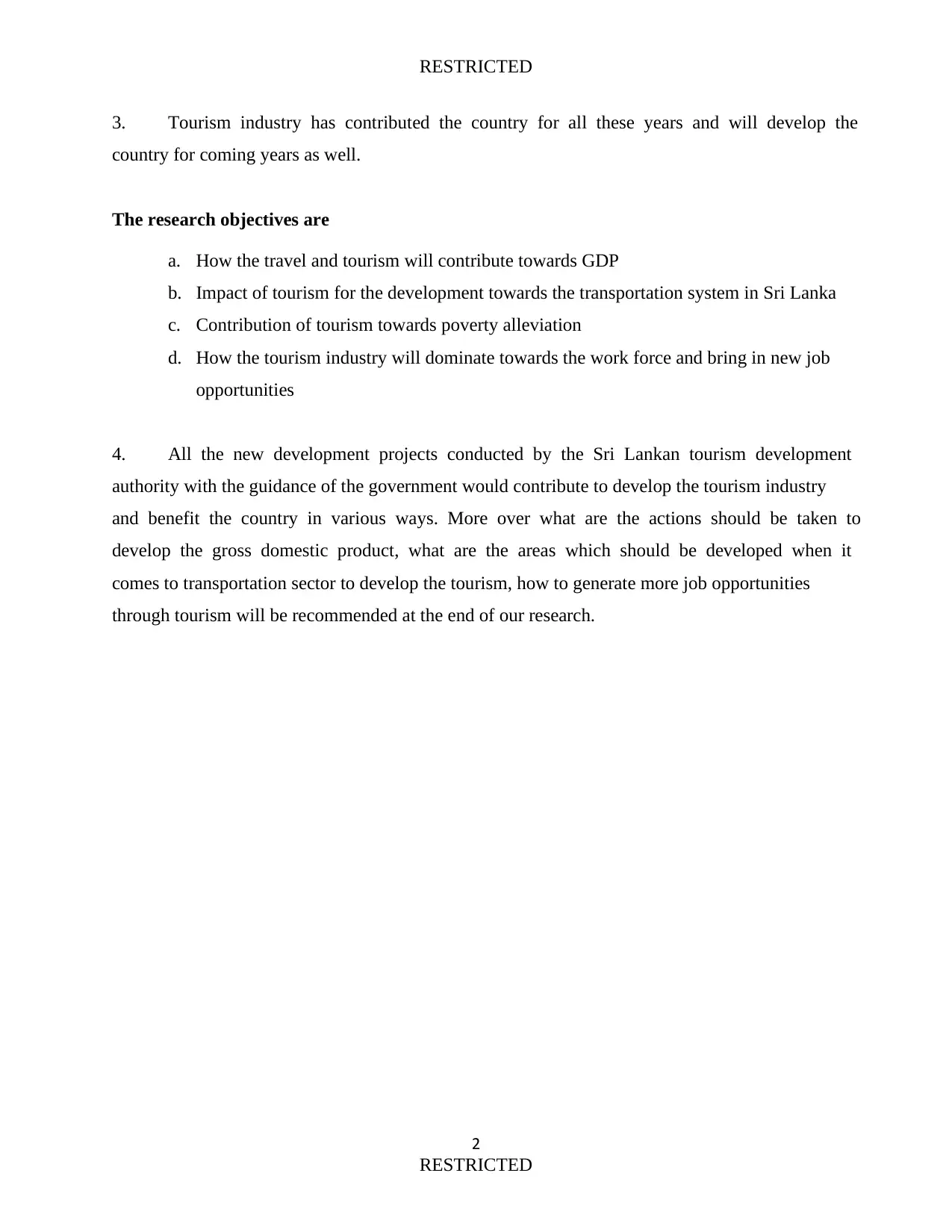
RESTRICTED
2
RESTRICTED
3. Tourism industry has contributed the country for all these years and will develop the
country for coming years as well.
The research objectives are
a. How the travel and tourism will contribute towards GDP
b. Impact of tourism for the development towards the transportation system in Sri Lanka
c. Contribution of tourism towards poverty alleviation
d. How the tourism industry will dominate towards the work force and bring in new job
opportunities
4. All the new development projects conducted by the Sri Lankan tourism development
authority with the guidance of the government would contribute to develop the tourism industry
and benefit the country in various ways. More over what are the actions should be taken to
develop the gross domestic product, what are the areas which should be developed when it
comes to transportation sector to develop the tourism, how to generate more job opportunities
through tourism will be recommended at the end of our research.
2
RESTRICTED
3. Tourism industry has contributed the country for all these years and will develop the
country for coming years as well.
The research objectives are
a. How the travel and tourism will contribute towards GDP
b. Impact of tourism for the development towards the transportation system in Sri Lanka
c. Contribution of tourism towards poverty alleviation
d. How the tourism industry will dominate towards the work force and bring in new job
opportunities
4. All the new development projects conducted by the Sri Lankan tourism development
authority with the guidance of the government would contribute to develop the tourism industry
and benefit the country in various ways. More over what are the actions should be taken to
develop the gross domestic product, what are the areas which should be developed when it
comes to transportation sector to develop the tourism, how to generate more job opportunities
through tourism will be recommended at the end of our research.
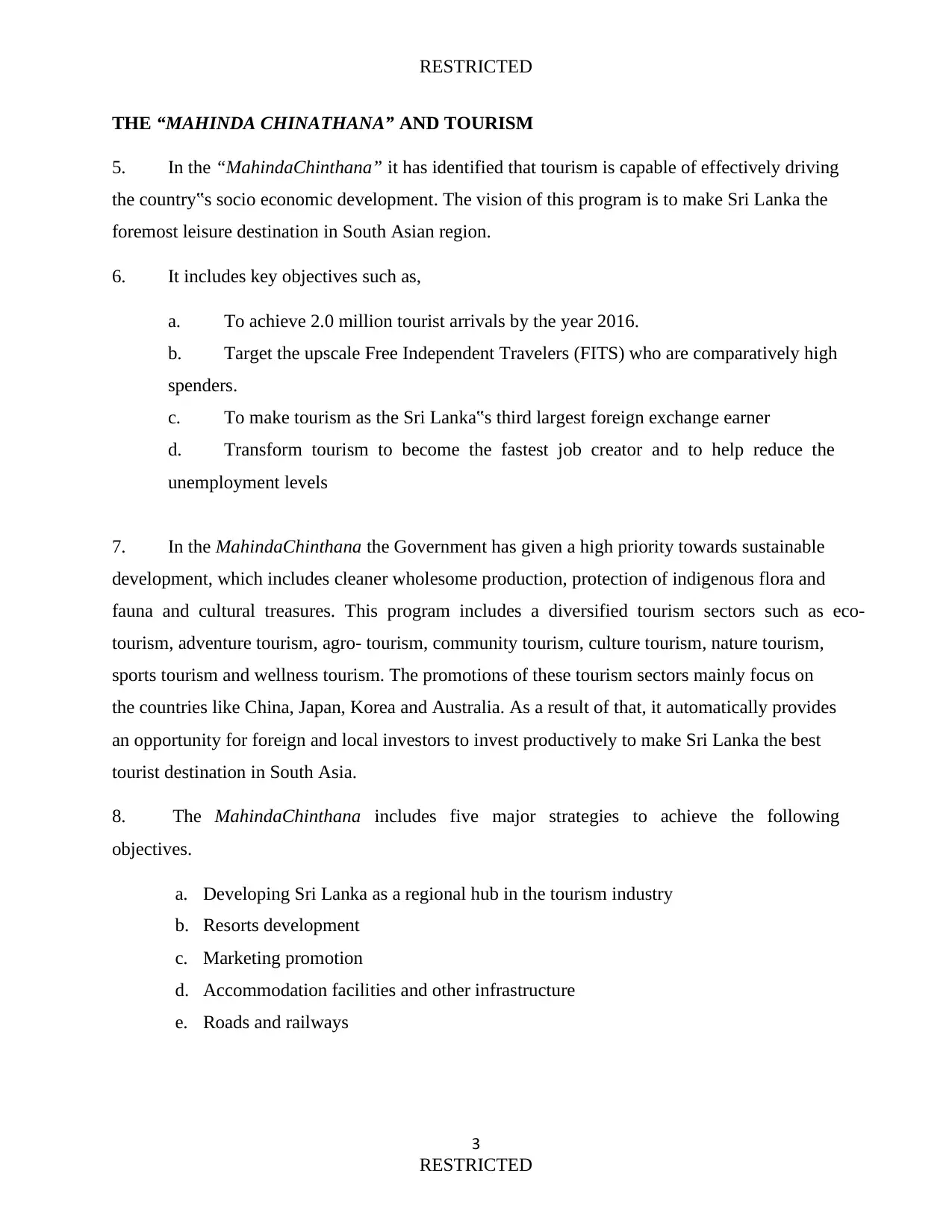
RESTRICTED
3
RESTRICTED
THE “MAHINDA CHINATHANA” AND TOURISM
5. In the “MahindaChinthana” it has identified that tourism is capable of effectively driving
the country‟s socio economic development. The vision of this program is to make Sri Lanka the
foremost leisure destination in South Asian region.
6. It includes key objectives such as,
a. To achieve 2.0 million tourist arrivals by the year 2016.
b. Target the upscale Free Independent Travelers (FITS) who are comparatively high
spenders.
c. To make tourism as the Sri Lanka‟s third largest foreign exchange earner
d. Transform tourism to become the fastest job creator and to help reduce the
unemployment levels
7. In the MahindaChinthana the Government has given a high priority towards sustainable
development, which includes cleaner wholesome production, protection of indigenous flora and
fauna and cultural treasures. This program includes a diversified tourism sectors such as eco-
tourism, adventure tourism, agro- tourism, community tourism, culture tourism, nature tourism,
sports tourism and wellness tourism. The promotions of these tourism sectors mainly focus on
the countries like China, Japan, Korea and Australia. As a result of that, it automatically provides
an opportunity for foreign and local investors to invest productively to make Sri Lanka the best
tourist destination in South Asia.
8. The MahindaChinthana includes five major strategies to achieve the following
objectives.
a. Developing Sri Lanka as a regional hub in the tourism industry
b. Resorts development
c. Marketing promotion
d. Accommodation facilities and other infrastructure
e. Roads and railways
3
RESTRICTED
THE “MAHINDA CHINATHANA” AND TOURISM
5. In the “MahindaChinthana” it has identified that tourism is capable of effectively driving
the country‟s socio economic development. The vision of this program is to make Sri Lanka the
foremost leisure destination in South Asian region.
6. It includes key objectives such as,
a. To achieve 2.0 million tourist arrivals by the year 2016.
b. Target the upscale Free Independent Travelers (FITS) who are comparatively high
spenders.
c. To make tourism as the Sri Lanka‟s third largest foreign exchange earner
d. Transform tourism to become the fastest job creator and to help reduce the
unemployment levels
7. In the MahindaChinthana the Government has given a high priority towards sustainable
development, which includes cleaner wholesome production, protection of indigenous flora and
fauna and cultural treasures. This program includes a diversified tourism sectors such as eco-
tourism, adventure tourism, agro- tourism, community tourism, culture tourism, nature tourism,
sports tourism and wellness tourism. The promotions of these tourism sectors mainly focus on
the countries like China, Japan, Korea and Australia. As a result of that, it automatically provides
an opportunity for foreign and local investors to invest productively to make Sri Lanka the best
tourist destination in South Asia.
8. The MahindaChinthana includes five major strategies to achieve the following
objectives.
a. Developing Sri Lanka as a regional hub in the tourism industry
b. Resorts development
c. Marketing promotion
d. Accommodation facilities and other infrastructure
e. Roads and railways
⊘ This is a preview!⊘
Do you want full access?
Subscribe today to unlock all pages.

Trusted by 1+ million students worldwide
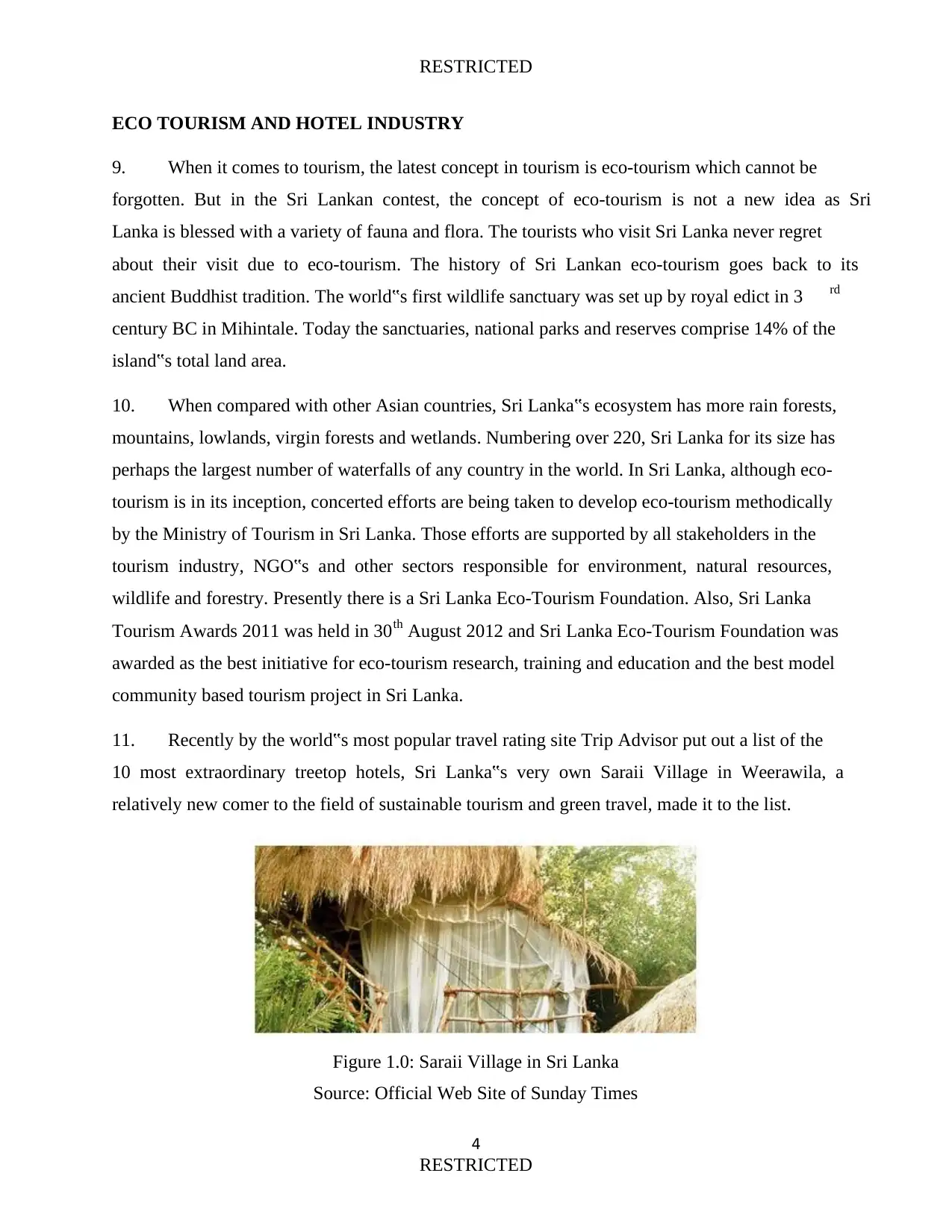
RESTRICTED
4
RESTRICTED
ECO TOURISM AND HOTEL INDUSTRY
9. When it comes to tourism, the latest concept in tourism is eco-tourism which cannot be
forgotten. But in the Sri Lankan contest, the concept of eco-tourism is not a new idea as Sri
Lanka is blessed with a variety of fauna and flora. The tourists who visit Sri Lanka never regret
about their visit due to eco-tourism. The history of Sri Lankan eco-tourism goes back to its
ancient Buddhist tradition. The world‟s first wildlife sanctuary was set up by royal edict in 3 rd
century BC in Mihintale. Today the sanctuaries, national parks and reserves comprise 14% of the
island‟s total land area.
10. When compared with other Asian countries, Sri Lanka‟s ecosystem has more rain forests,
mountains, lowlands, virgin forests and wetlands. Numbering over 220, Sri Lanka for its size has
perhaps the largest number of waterfalls of any country in the world. In Sri Lanka, although eco-
tourism is in its inception, concerted efforts are being taken to develop eco-tourism methodically
by the Ministry of Tourism in Sri Lanka. Those efforts are supported by all stakeholders in the
tourism industry, NGO‟s and other sectors responsible for environment, natural resources,
wildlife and forestry. Presently there is a Sri Lanka Eco-Tourism Foundation. Also, Sri Lanka
Tourism Awards 2011 was held in 30th August 2012 and Sri Lanka Eco-Tourism Foundation was
awarded as the best initiative for eco-tourism research, training and education and the best model
community based tourism project in Sri Lanka.
11. Recently by the world‟s most popular travel rating site Trip Advisor put out a list of the
10 most extraordinary treetop hotels, Sri Lanka‟s very own Saraii Village in Weerawila, a
relatively new comer to the field of sustainable tourism and green travel, made it to the list.
Figure 1.0: Saraii Village in Sri Lanka
Source: Official Web Site of Sunday Times
4
RESTRICTED
ECO TOURISM AND HOTEL INDUSTRY
9. When it comes to tourism, the latest concept in tourism is eco-tourism which cannot be
forgotten. But in the Sri Lankan contest, the concept of eco-tourism is not a new idea as Sri
Lanka is blessed with a variety of fauna and flora. The tourists who visit Sri Lanka never regret
about their visit due to eco-tourism. The history of Sri Lankan eco-tourism goes back to its
ancient Buddhist tradition. The world‟s first wildlife sanctuary was set up by royal edict in 3 rd
century BC in Mihintale. Today the sanctuaries, national parks and reserves comprise 14% of the
island‟s total land area.
10. When compared with other Asian countries, Sri Lanka‟s ecosystem has more rain forests,
mountains, lowlands, virgin forests and wetlands. Numbering over 220, Sri Lanka for its size has
perhaps the largest number of waterfalls of any country in the world. In Sri Lanka, although eco-
tourism is in its inception, concerted efforts are being taken to develop eco-tourism methodically
by the Ministry of Tourism in Sri Lanka. Those efforts are supported by all stakeholders in the
tourism industry, NGO‟s and other sectors responsible for environment, natural resources,
wildlife and forestry. Presently there is a Sri Lanka Eco-Tourism Foundation. Also, Sri Lanka
Tourism Awards 2011 was held in 30th August 2012 and Sri Lanka Eco-Tourism Foundation was
awarded as the best initiative for eco-tourism research, training and education and the best model
community based tourism project in Sri Lanka.
11. Recently by the world‟s most popular travel rating site Trip Advisor put out a list of the
10 most extraordinary treetop hotels, Sri Lanka‟s very own Saraii Village in Weerawila, a
relatively new comer to the field of sustainable tourism and green travel, made it to the list.
Figure 1.0: Saraii Village in Sri Lanka
Source: Official Web Site of Sunday Times
Paraphrase This Document
Need a fresh take? Get an instant paraphrase of this document with our AI Paraphraser
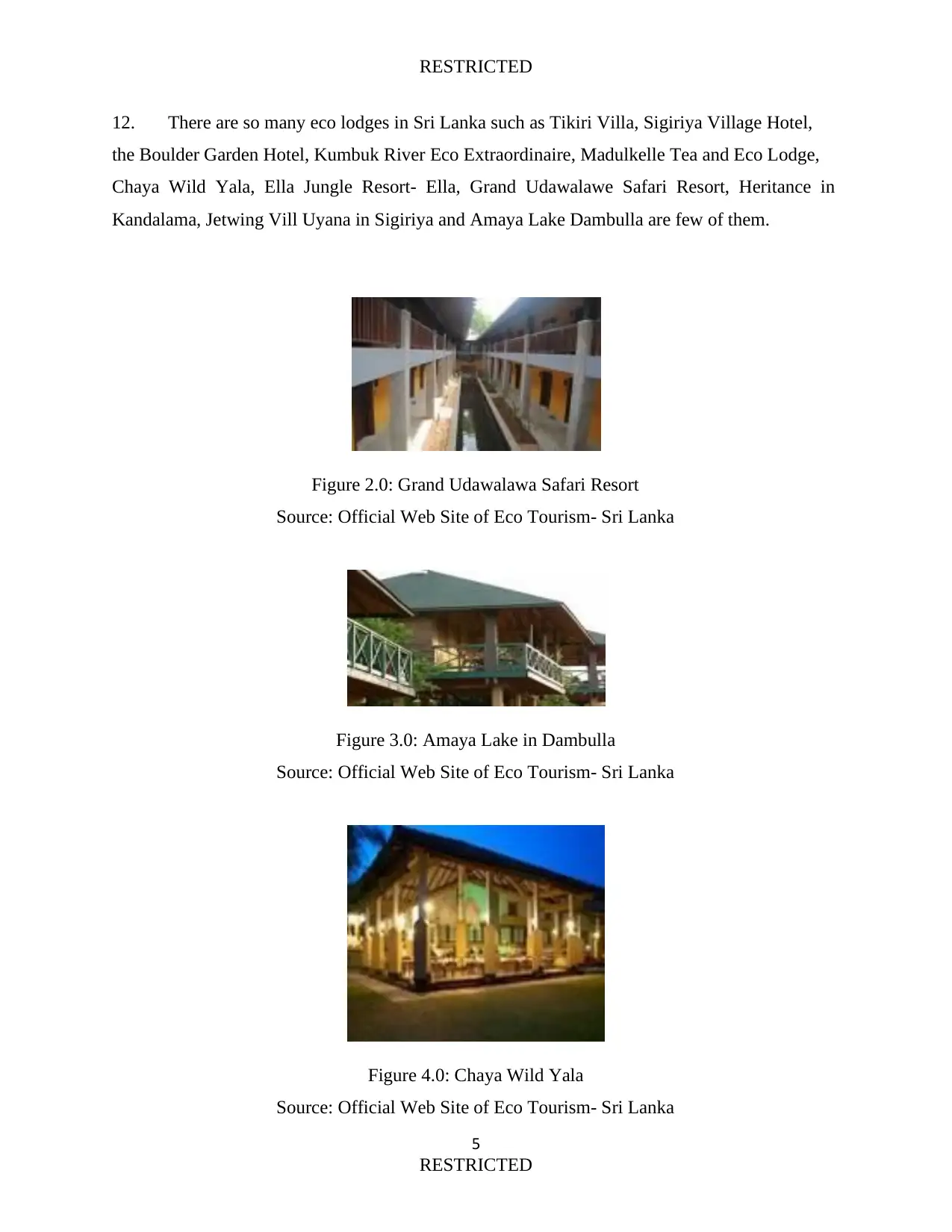
RESTRICTED
5
RESTRICTED
12. There are so many eco lodges in Sri Lanka such as Tikiri Villa, Sigiriya Village Hotel,
the Boulder Garden Hotel, Kumbuk River Eco Extraordinaire, Madulkelle Tea and Eco Lodge,
Chaya Wild Yala, Ella Jungle Resort- Ella, Grand Udawalawe Safari Resort, Heritance in
Kandalama, Jetwing Vill Uyana in Sigiriya and Amaya Lake Dambulla are few of them.
Figure 2.0: Grand Udawalawa Safari Resort
Source: Official Web Site of Eco Tourism- Sri Lanka
Figure 3.0: Amaya Lake in Dambulla
Source: Official Web Site of Eco Tourism- Sri Lanka
Figure 4.0: Chaya Wild Yala
Source: Official Web Site of Eco Tourism- Sri Lanka
5
RESTRICTED
12. There are so many eco lodges in Sri Lanka such as Tikiri Villa, Sigiriya Village Hotel,
the Boulder Garden Hotel, Kumbuk River Eco Extraordinaire, Madulkelle Tea and Eco Lodge,
Chaya Wild Yala, Ella Jungle Resort- Ella, Grand Udawalawe Safari Resort, Heritance in
Kandalama, Jetwing Vill Uyana in Sigiriya and Amaya Lake Dambulla are few of them.
Figure 2.0: Grand Udawalawa Safari Resort
Source: Official Web Site of Eco Tourism- Sri Lanka
Figure 3.0: Amaya Lake in Dambulla
Source: Official Web Site of Eco Tourism- Sri Lanka
Figure 4.0: Chaya Wild Yala
Source: Official Web Site of Eco Tourism- Sri Lanka
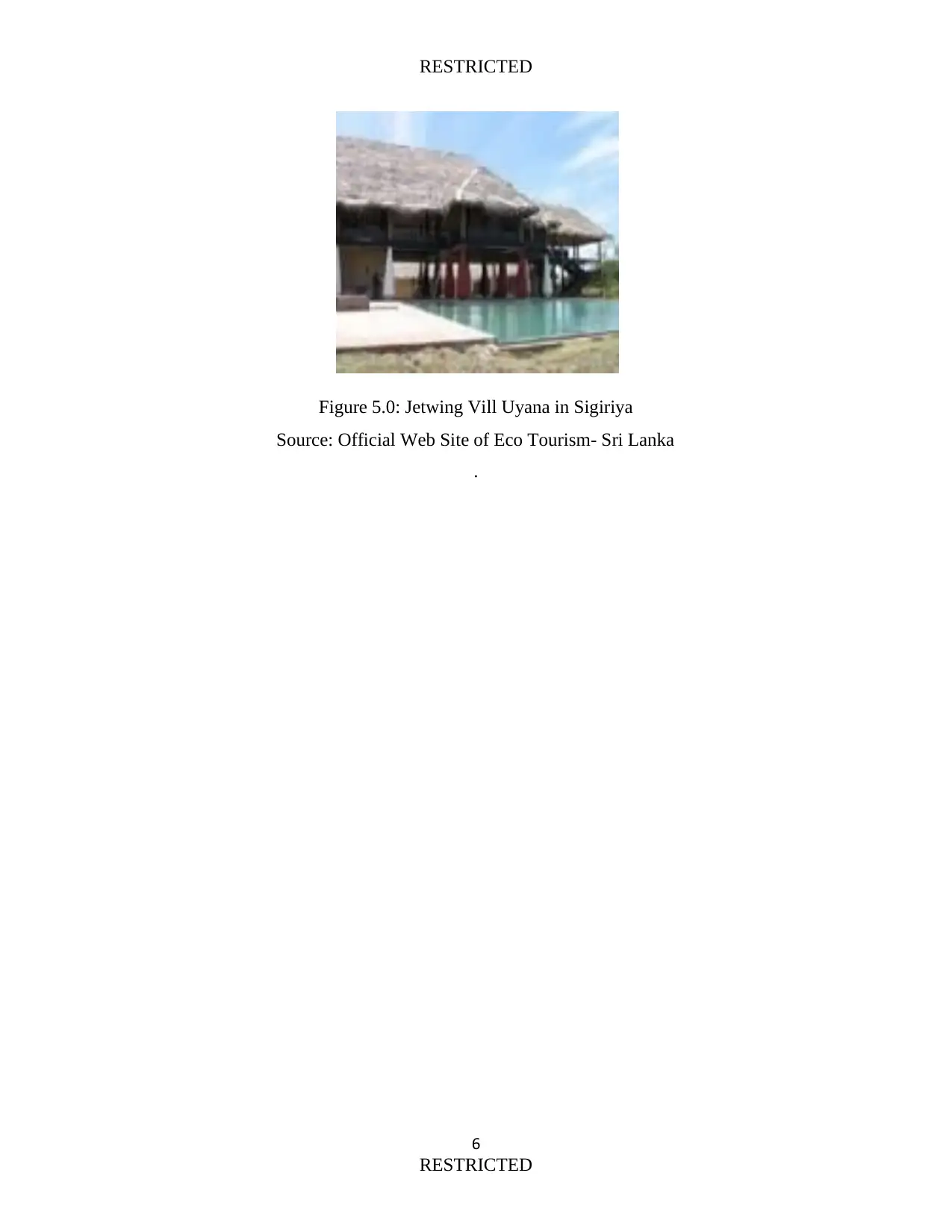
RESTRICTED
6
RESTRICTED
Figure 5.0: Jetwing Vill Uyana in Sigiriya
Source: Official Web Site of Eco Tourism- Sri Lanka
.
6
RESTRICTED
Figure 5.0: Jetwing Vill Uyana in Sigiriya
Source: Official Web Site of Eco Tourism- Sri Lanka
.
⊘ This is a preview!⊘
Do you want full access?
Subscribe today to unlock all pages.

Trusted by 1+ million students worldwide
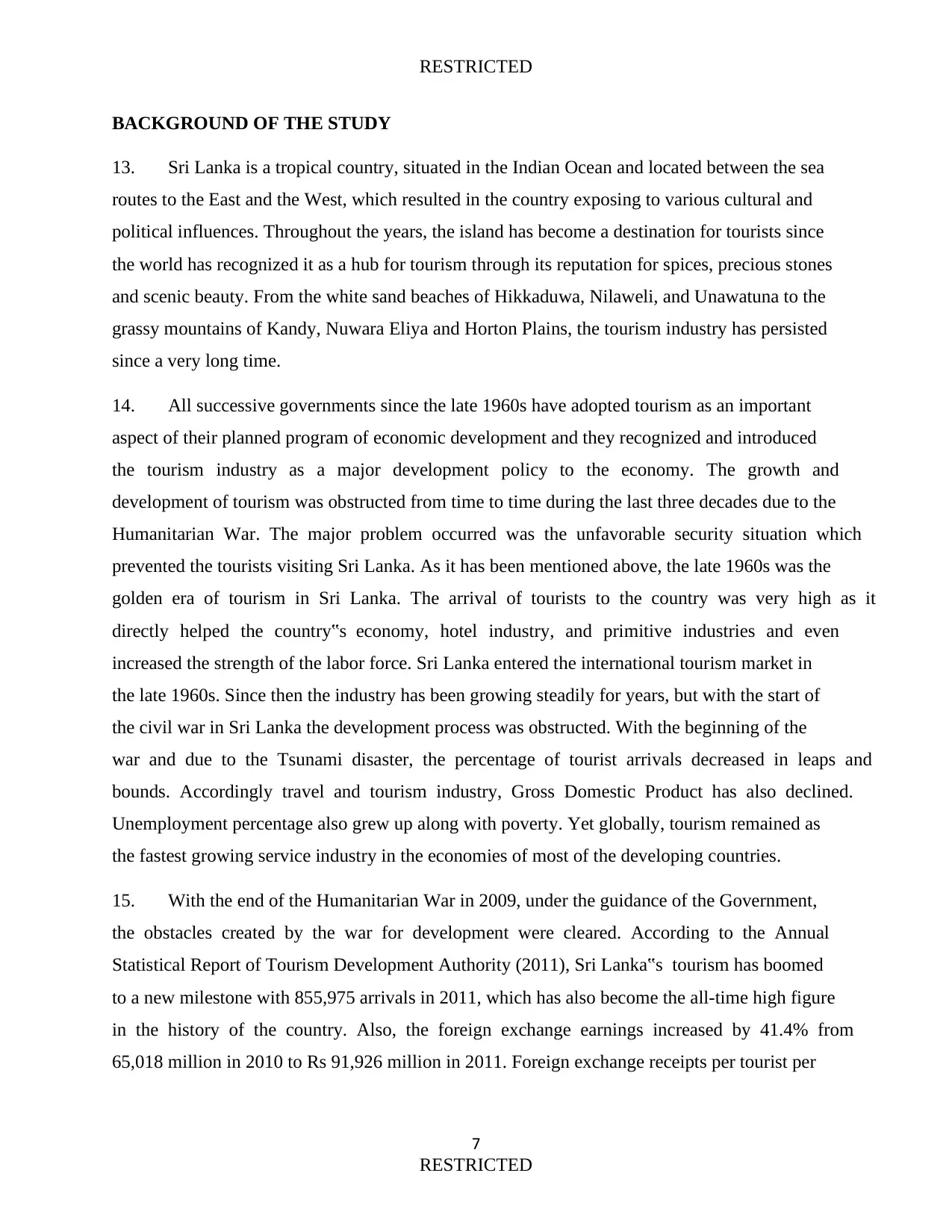
RESTRICTED
7
RESTRICTED
BACKGROUND OF THE STUDY
13. Sri Lanka is a tropical country, situated in the Indian Ocean and located between the sea
routes to the East and the West, which resulted in the country exposing to various cultural and
political influences. Throughout the years, the island has become a destination for tourists since
the world has recognized it as a hub for tourism through its reputation for spices, precious stones
and scenic beauty. From the white sand beaches of Hikkaduwa, Nilaweli, and Unawatuna to the
grassy mountains of Kandy, Nuwara Eliya and Horton Plains, the tourism industry has persisted
since a very long time.
14. All successive governments since the late 1960s have adopted tourism as an important
aspect of their planned program of economic development and they recognized and introduced
the tourism industry as a major development policy to the economy. The growth and
development of tourism was obstructed from time to time during the last three decades due to the
Humanitarian War. The major problem occurred was the unfavorable security situation which
prevented the tourists visiting Sri Lanka. As it has been mentioned above, the late 1960s was the
golden era of tourism in Sri Lanka. The arrival of tourists to the country was very high as it
directly helped the country‟s economy, hotel industry, and primitive industries and even
increased the strength of the labor force. Sri Lanka entered the international tourism market in
the late 1960s. Since then the industry has been growing steadily for years, but with the start of
the civil war in Sri Lanka the development process was obstructed. With the beginning of the
war and due to the Tsunami disaster, the percentage of tourist arrivals decreased in leaps and
bounds. Accordingly travel and tourism industry, Gross Domestic Product has also declined.
Unemployment percentage also grew up along with poverty. Yet globally, tourism remained as
the fastest growing service industry in the economies of most of the developing countries.
15. With the end of the Humanitarian War in 2009, under the guidance of the Government,
the obstacles created by the war for development were cleared. According to the Annual
Statistical Report of Tourism Development Authority (2011), Sri Lanka‟s tourism has boomed
to a new milestone with 855,975 arrivals in 2011, which has also become the all-time high figure
in the history of the country. Also, the foreign exchange earnings increased by 41.4% from
65,018 million in 2010 to Rs 91,926 million in 2011. Foreign exchange receipts per tourist per
7
RESTRICTED
BACKGROUND OF THE STUDY
13. Sri Lanka is a tropical country, situated in the Indian Ocean and located between the sea
routes to the East and the West, which resulted in the country exposing to various cultural and
political influences. Throughout the years, the island has become a destination for tourists since
the world has recognized it as a hub for tourism through its reputation for spices, precious stones
and scenic beauty. From the white sand beaches of Hikkaduwa, Nilaweli, and Unawatuna to the
grassy mountains of Kandy, Nuwara Eliya and Horton Plains, the tourism industry has persisted
since a very long time.
14. All successive governments since the late 1960s have adopted tourism as an important
aspect of their planned program of economic development and they recognized and introduced
the tourism industry as a major development policy to the economy. The growth and
development of tourism was obstructed from time to time during the last three decades due to the
Humanitarian War. The major problem occurred was the unfavorable security situation which
prevented the tourists visiting Sri Lanka. As it has been mentioned above, the late 1960s was the
golden era of tourism in Sri Lanka. The arrival of tourists to the country was very high as it
directly helped the country‟s economy, hotel industry, and primitive industries and even
increased the strength of the labor force. Sri Lanka entered the international tourism market in
the late 1960s. Since then the industry has been growing steadily for years, but with the start of
the civil war in Sri Lanka the development process was obstructed. With the beginning of the
war and due to the Tsunami disaster, the percentage of tourist arrivals decreased in leaps and
bounds. Accordingly travel and tourism industry, Gross Domestic Product has also declined.
Unemployment percentage also grew up along with poverty. Yet globally, tourism remained as
the fastest growing service industry in the economies of most of the developing countries.
15. With the end of the Humanitarian War in 2009, under the guidance of the Government,
the obstacles created by the war for development were cleared. According to the Annual
Statistical Report of Tourism Development Authority (2011), Sri Lanka‟s tourism has boomed
to a new milestone with 855,975 arrivals in 2011, which has also become the all-time high figure
in the history of the country. Also, the foreign exchange earnings increased by 41.4% from
65,018 million in 2010 to Rs 91,926 million in 2011. Foreign exchange receipts per tourist per
Paraphrase This Document
Need a fresh take? Get an instant paraphrase of this document with our AI Paraphraser
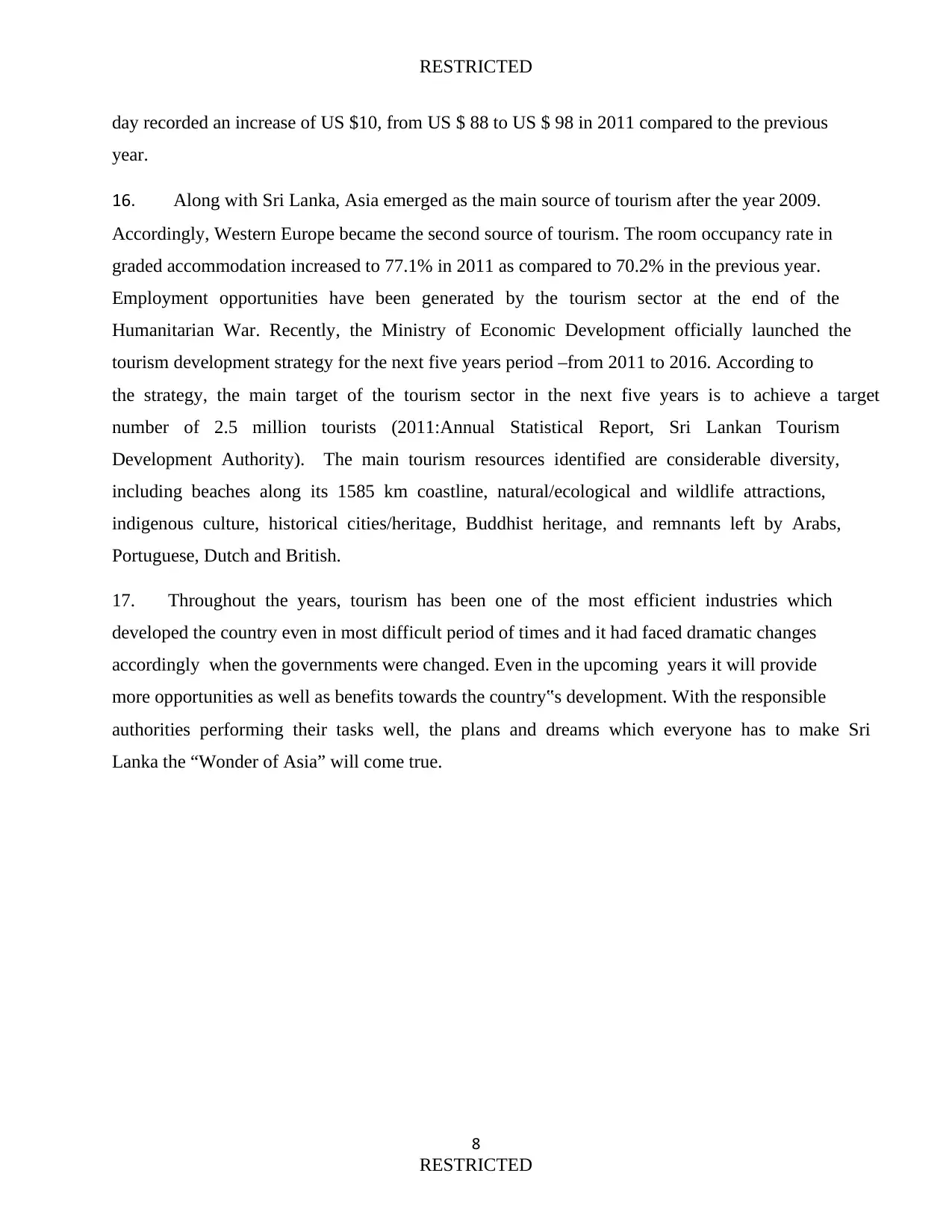
RESTRICTED
8
RESTRICTED
day recorded an increase of US $10, from US $ 88 to US $ 98 in 2011 compared to the previous
year.
16. Along with Sri Lanka, Asia emerged as the main source of tourism after the year 2009.
Accordingly, Western Europe became the second source of tourism. The room occupancy rate in
graded accommodation increased to 77.1% in 2011 as compared to 70.2% in the previous year.
Employment opportunities have been generated by the tourism sector at the end of the
Humanitarian War. Recently, the Ministry of Economic Development officially launched the
tourism development strategy for the next five years period –from 2011 to 2016. According to
the strategy, the main target of the tourism sector in the next five years is to achieve a target
number of 2.5 million tourists (2011:Annual Statistical Report, Sri Lankan Tourism
Development Authority). The main tourism resources identified are considerable diversity,
including beaches along its 1585 km coastline, natural/ecological and wildlife attractions,
indigenous culture, historical cities/heritage, Buddhist heritage, and remnants left by Arabs,
Portuguese, Dutch and British.
17. Throughout the years, tourism has been one of the most efficient industries which
developed the country even in most difficult period of times and it had faced dramatic changes
accordingly when the governments were changed. Even in the upcoming years it will provide
more opportunities as well as benefits towards the country‟s development. With the responsible
authorities performing their tasks well, the plans and dreams which everyone has to make Sri
Lanka the “Wonder of Asia” will come true.
8
RESTRICTED
day recorded an increase of US $10, from US $ 88 to US $ 98 in 2011 compared to the previous
year.
16. Along with Sri Lanka, Asia emerged as the main source of tourism after the year 2009.
Accordingly, Western Europe became the second source of tourism. The room occupancy rate in
graded accommodation increased to 77.1% in 2011 as compared to 70.2% in the previous year.
Employment opportunities have been generated by the tourism sector at the end of the
Humanitarian War. Recently, the Ministry of Economic Development officially launched the
tourism development strategy for the next five years period –from 2011 to 2016. According to
the strategy, the main target of the tourism sector in the next five years is to achieve a target
number of 2.5 million tourists (2011:Annual Statistical Report, Sri Lankan Tourism
Development Authority). The main tourism resources identified are considerable diversity,
including beaches along its 1585 km coastline, natural/ecological and wildlife attractions,
indigenous culture, historical cities/heritage, Buddhist heritage, and remnants left by Arabs,
Portuguese, Dutch and British.
17. Throughout the years, tourism has been one of the most efficient industries which
developed the country even in most difficult period of times and it had faced dramatic changes
accordingly when the governments were changed. Even in the upcoming years it will provide
more opportunities as well as benefits towards the country‟s development. With the responsible
authorities performing their tasks well, the plans and dreams which everyone has to make Sri
Lanka the “Wonder of Asia” will come true.
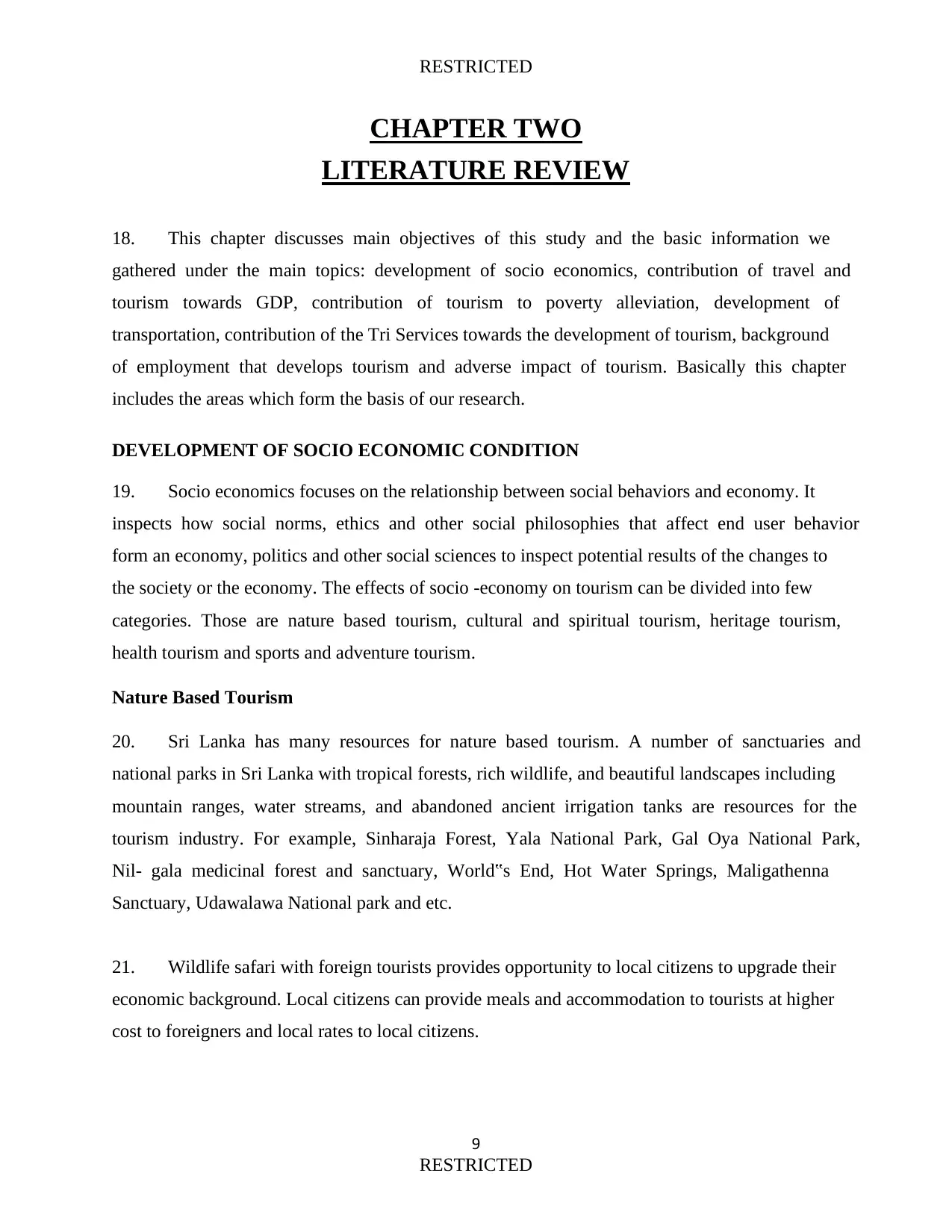
RESTRICTED
9
RESTRICTED
CHAPTER TWO
LITERATURE REVIEW
18. This chapter discusses main objectives of this study and the basic information we
gathered under the main topics: development of socio economics, contribution of travel and
tourism towards GDP, contribution of tourism to poverty alleviation, development of
transportation, contribution of the Tri Services towards the development of tourism, background
of employment that develops tourism and adverse impact of tourism. Basically this chapter
includes the areas which form the basis of our research.
DEVELOPMENT OF SOCIO ECONOMIC CONDITION
19. Socio economics focuses on the relationship between social behaviors and economy. It
inspects how social norms, ethics and other social philosophies that affect end user behavior
form an economy, politics and other social sciences to inspect potential results of the changes to
the society or the economy. The effects of socio -economy on tourism can be divided into few
categories. Those are nature based tourism, cultural and spiritual tourism, heritage tourism,
health tourism and sports and adventure tourism.
Nature Based Tourism
20. Sri Lanka has many resources for nature based tourism. A number of sanctuaries and
national parks in Sri Lanka with tropical forests, rich wildlife, and beautiful landscapes including
mountain ranges, water streams, and abandoned ancient irrigation tanks are resources for the
tourism industry. For example, Sinharaja Forest, Yala National Park, Gal Oya National Park,
Nil- gala medicinal forest and sanctuary, World‟s End, Hot Water Springs, Maligathenna
Sanctuary, Udawalawa National park and etc.
21. Wildlife safari with foreign tourists provides opportunity to local citizens to upgrade their
economic background. Local citizens can provide meals and accommodation to tourists at higher
cost to foreigners and local rates to local citizens.
9
RESTRICTED
CHAPTER TWO
LITERATURE REVIEW
18. This chapter discusses main objectives of this study and the basic information we
gathered under the main topics: development of socio economics, contribution of travel and
tourism towards GDP, contribution of tourism to poverty alleviation, development of
transportation, contribution of the Tri Services towards the development of tourism, background
of employment that develops tourism and adverse impact of tourism. Basically this chapter
includes the areas which form the basis of our research.
DEVELOPMENT OF SOCIO ECONOMIC CONDITION
19. Socio economics focuses on the relationship between social behaviors and economy. It
inspects how social norms, ethics and other social philosophies that affect end user behavior
form an economy, politics and other social sciences to inspect potential results of the changes to
the society or the economy. The effects of socio -economy on tourism can be divided into few
categories. Those are nature based tourism, cultural and spiritual tourism, heritage tourism,
health tourism and sports and adventure tourism.
Nature Based Tourism
20. Sri Lanka has many resources for nature based tourism. A number of sanctuaries and
national parks in Sri Lanka with tropical forests, rich wildlife, and beautiful landscapes including
mountain ranges, water streams, and abandoned ancient irrigation tanks are resources for the
tourism industry. For example, Sinharaja Forest, Yala National Park, Gal Oya National Park,
Nil- gala medicinal forest and sanctuary, World‟s End, Hot Water Springs, Maligathenna
Sanctuary, Udawalawa National park and etc.
21. Wildlife safari with foreign tourists provides opportunity to local citizens to upgrade their
economic background. Local citizens can provide meals and accommodation to tourists at higher
cost to foreigners and local rates to local citizens.
⊘ This is a preview!⊘
Do you want full access?
Subscribe today to unlock all pages.

Trusted by 1+ million students worldwide
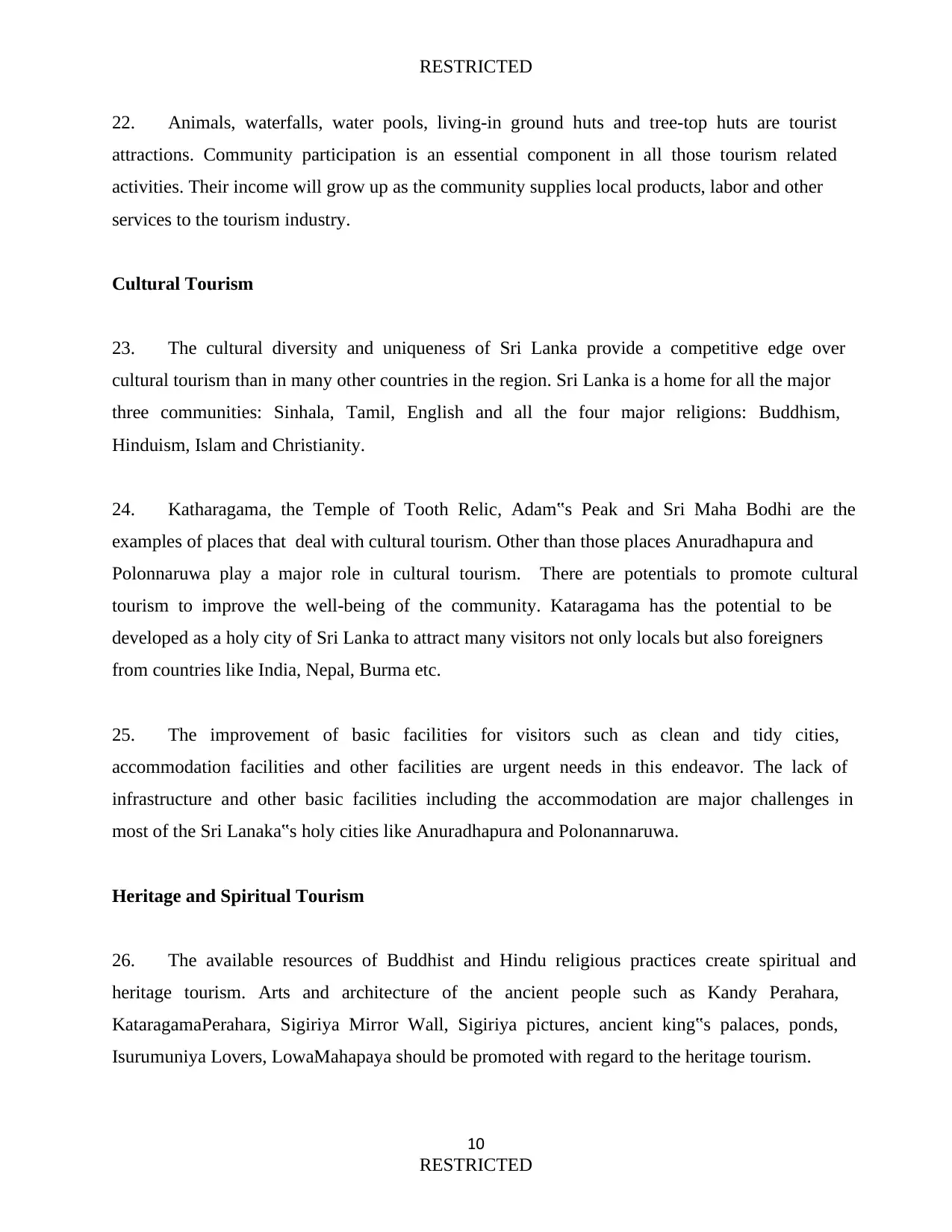
RESTRICTED
10
RESTRICTED
22. Animals, waterfalls, water pools, living-in ground huts and tree-top huts are tourist
attractions. Community participation is an essential component in all those tourism related
activities. Their income will grow up as the community supplies local products, labor and other
services to the tourism industry.
Cultural Tourism
23. The cultural diversity and uniqueness of Sri Lanka provide a competitive edge over
cultural tourism than in many other countries in the region. Sri Lanka is a home for all the major
three communities: Sinhala, Tamil, English and all the four major religions: Buddhism,
Hinduism, Islam and Christianity.
24. Katharagama, the Temple of Tooth Relic, Adam‟s Peak and Sri Maha Bodhi are the
examples of places that deal with cultural tourism. Other than those places Anuradhapura and
Polonnaruwa play a major role in cultural tourism. There are potentials to promote cultural
tourism to improve the well-being of the community. Kataragama has the potential to be
developed as a holy city of Sri Lanka to attract many visitors not only locals but also foreigners
from countries like India, Nepal, Burma etc.
25. The improvement of basic facilities for visitors such as clean and tidy cities,
accommodation facilities and other facilities are urgent needs in this endeavor. The lack of
infrastructure and other basic facilities including the accommodation are major challenges in
most of the Sri Lanaka‟s holy cities like Anuradhapura and Polonannaruwa.
Heritage and Spiritual Tourism
26. The available resources of Buddhist and Hindu religious practices create spiritual and
heritage tourism. Arts and architecture of the ancient people such as Kandy Perahara,
KataragamaPerahara, Sigiriya Mirror Wall, Sigiriya pictures, ancient king‟s palaces, ponds,
Isurumuniya Lovers, LowaMahapaya should be promoted with regard to the heritage tourism.
10
RESTRICTED
22. Animals, waterfalls, water pools, living-in ground huts and tree-top huts are tourist
attractions. Community participation is an essential component in all those tourism related
activities. Their income will grow up as the community supplies local products, labor and other
services to the tourism industry.
Cultural Tourism
23. The cultural diversity and uniqueness of Sri Lanka provide a competitive edge over
cultural tourism than in many other countries in the region. Sri Lanka is a home for all the major
three communities: Sinhala, Tamil, English and all the four major religions: Buddhism,
Hinduism, Islam and Christianity.
24. Katharagama, the Temple of Tooth Relic, Adam‟s Peak and Sri Maha Bodhi are the
examples of places that deal with cultural tourism. Other than those places Anuradhapura and
Polonnaruwa play a major role in cultural tourism. There are potentials to promote cultural
tourism to improve the well-being of the community. Kataragama has the potential to be
developed as a holy city of Sri Lanka to attract many visitors not only locals but also foreigners
from countries like India, Nepal, Burma etc.
25. The improvement of basic facilities for visitors such as clean and tidy cities,
accommodation facilities and other facilities are urgent needs in this endeavor. The lack of
infrastructure and other basic facilities including the accommodation are major challenges in
most of the Sri Lanaka‟s holy cities like Anuradhapura and Polonannaruwa.
Heritage and Spiritual Tourism
26. The available resources of Buddhist and Hindu religious practices create spiritual and
heritage tourism. Arts and architecture of the ancient people such as Kandy Perahara,
KataragamaPerahara, Sigiriya Mirror Wall, Sigiriya pictures, ancient king‟s palaces, ponds,
Isurumuniya Lovers, LowaMahapaya should be promoted with regard to the heritage tourism.
Paraphrase This Document
Need a fresh take? Get an instant paraphrase of this document with our AI Paraphraser
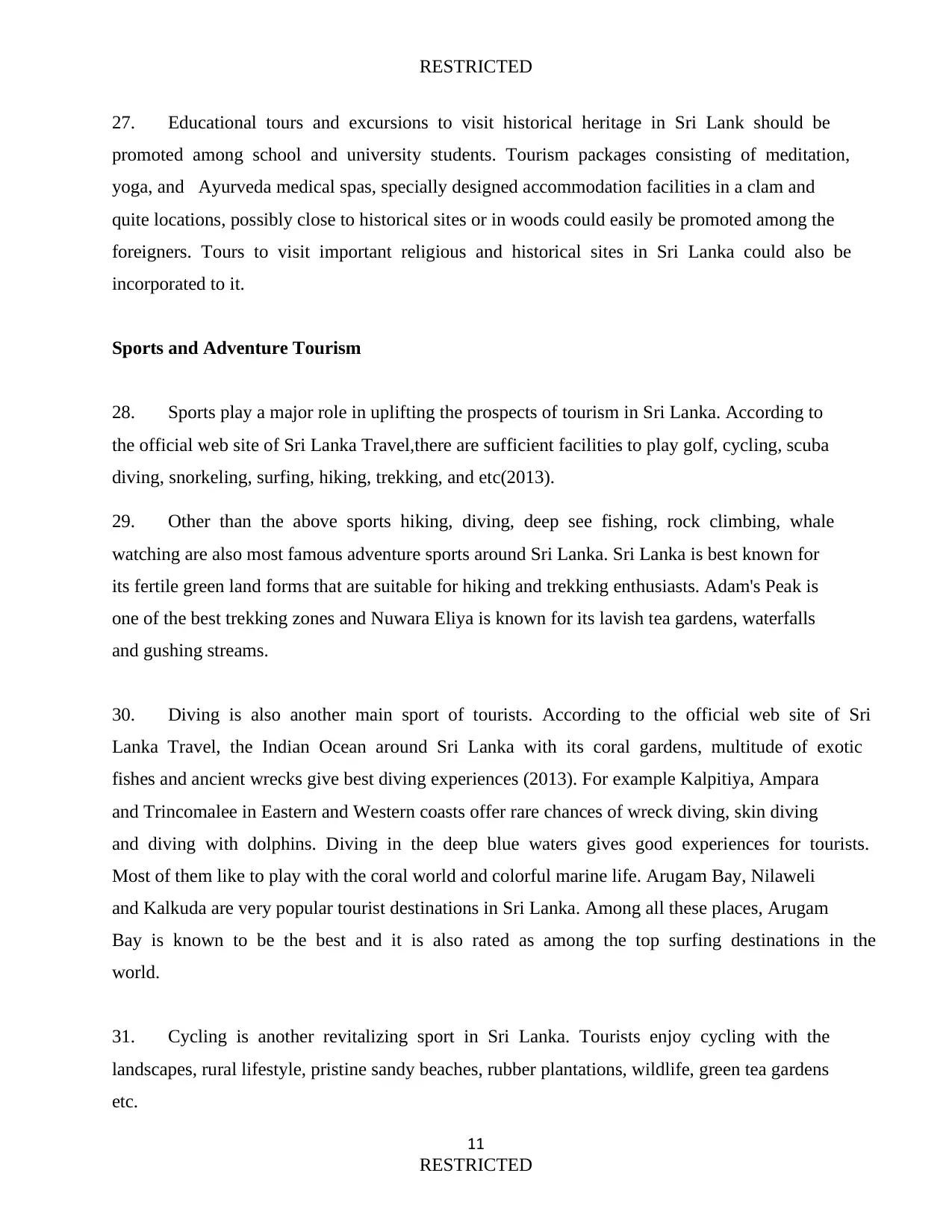
RESTRICTED
11
RESTRICTED
27. Educational tours and excursions to visit historical heritage in Sri Lank should be
promoted among school and university students. Tourism packages consisting of meditation,
yoga, and Ayurveda medical spas, specially designed accommodation facilities in a clam and
quite locations, possibly close to historical sites or in woods could easily be promoted among the
foreigners. Tours to visit important religious and historical sites in Sri Lanka could also be
incorporated to it.
Sports and Adventure Tourism
28. Sports play a major role in uplifting the prospects of tourism in Sri Lanka. According to
the official web site of Sri Lanka Travel,there are sufficient facilities to play golf, cycling, scuba
diving, snorkeling, surfing, hiking, trekking, and etc(2013).
29. Other than the above sports hiking, diving, deep see fishing, rock climbing, whale
watching are also most famous adventure sports around Sri Lanka. Sri Lanka is best known for
its fertile green land forms that are suitable for hiking and trekking enthusiasts. Adam's Peak is
one of the best trekking zones and Nuwara Eliya is known for its lavish tea gardens, waterfalls
and gushing streams.
30. Diving is also another main sport of tourists. According to the official web site of Sri
Lanka Travel, the Indian Ocean around Sri Lanka with its coral gardens, multitude of exotic
fishes and ancient wrecks give best diving experiences (2013). For example Kalpitiya, Ampara
and Trincomalee in Eastern and Western coasts offer rare chances of wreck diving, skin diving
and diving with dolphins. Diving in the deep blue waters gives good experiences for tourists.
Most of them like to play with the coral world and colorful marine life. Arugam Bay, Nilaweli
and Kalkuda are very popular tourist destinations in Sri Lanka. Among all these places, Arugam
Bay is known to be the best and it is also rated as among the top surfing destinations in the
world.
31. Cycling is another revitalizing sport in Sri Lanka. Tourists enjoy cycling with the
landscapes, rural lifestyle, pristine sandy beaches, rubber plantations, wildlife, green tea gardens
etc.
11
RESTRICTED
27. Educational tours and excursions to visit historical heritage in Sri Lank should be
promoted among school and university students. Tourism packages consisting of meditation,
yoga, and Ayurveda medical spas, specially designed accommodation facilities in a clam and
quite locations, possibly close to historical sites or in woods could easily be promoted among the
foreigners. Tours to visit important religious and historical sites in Sri Lanka could also be
incorporated to it.
Sports and Adventure Tourism
28. Sports play a major role in uplifting the prospects of tourism in Sri Lanka. According to
the official web site of Sri Lanka Travel,there are sufficient facilities to play golf, cycling, scuba
diving, snorkeling, surfing, hiking, trekking, and etc(2013).
29. Other than the above sports hiking, diving, deep see fishing, rock climbing, whale
watching are also most famous adventure sports around Sri Lanka. Sri Lanka is best known for
its fertile green land forms that are suitable for hiking and trekking enthusiasts. Adam's Peak is
one of the best trekking zones and Nuwara Eliya is known for its lavish tea gardens, waterfalls
and gushing streams.
30. Diving is also another main sport of tourists. According to the official web site of Sri
Lanka Travel, the Indian Ocean around Sri Lanka with its coral gardens, multitude of exotic
fishes and ancient wrecks give best diving experiences (2013). For example Kalpitiya, Ampara
and Trincomalee in Eastern and Western coasts offer rare chances of wreck diving, skin diving
and diving with dolphins. Diving in the deep blue waters gives good experiences for tourists.
Most of them like to play with the coral world and colorful marine life. Arugam Bay, Nilaweli
and Kalkuda are very popular tourist destinations in Sri Lanka. Among all these places, Arugam
Bay is known to be the best and it is also rated as among the top surfing destinations in the
world.
31. Cycling is another revitalizing sport in Sri Lanka. Tourists enjoy cycling with the
landscapes, rural lifestyle, pristine sandy beaches, rubber plantations, wildlife, green tea gardens
etc.
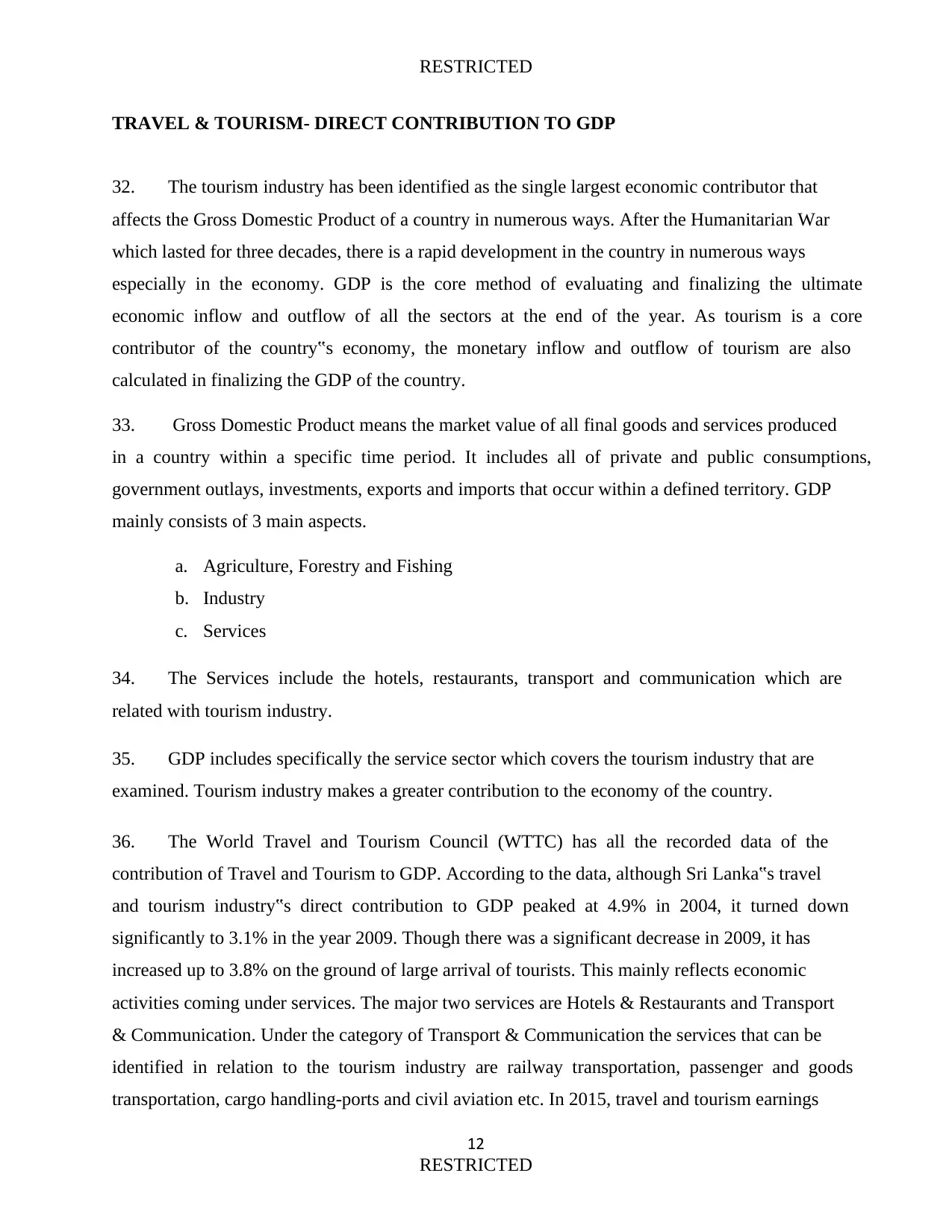
RESTRICTED
12
RESTRICTED
TRAVEL & TOURISM- DIRECT CONTRIBUTION TO GDP
32. The tourism industry has been identified as the single largest economic contributor that
affects the Gross Domestic Product of a country in numerous ways. After the Humanitarian War
which lasted for three decades, there is a rapid development in the country in numerous ways
especially in the economy. GDP is the core method of evaluating and finalizing the ultimate
economic inflow and outflow of all the sectors at the end of the year. As tourism is a core
contributor of the country‟s economy, the monetary inflow and outflow of tourism are also
calculated in finalizing the GDP of the country.
33. Gross Domestic Product means the market value of all final goods and services produced
in a country within a specific time period. It includes all of private and public consumptions,
government outlays, investments, exports and imports that occur within a defined territory. GDP
mainly consists of 3 main aspects.
a. Agriculture, Forestry and Fishing
b. Industry
c. Services
34. The Services include the hotels, restaurants, transport and communication which are
related with tourism industry.
35. GDP includes specifically the service sector which covers the tourism industry that are
examined. Tourism industry makes a greater contribution to the economy of the country.
36. The World Travel and Tourism Council (WTTC) has all the recorded data of the
contribution of Travel and Tourism to GDP. According to the data, although Sri Lanka‟s travel
and tourism industry‟s direct contribution to GDP peaked at 4.9% in 2004, it turned down
significantly to 3.1% in the year 2009. Though there was a significant decrease in 2009, it has
increased up to 3.8% on the ground of large arrival of tourists. This mainly reflects economic
activities coming under services. The major two services are Hotels & Restaurants and Transport
& Communication. Under the category of Transport & Communication the services that can be
identified in relation to the tourism industry are railway transportation, passenger and goods
transportation, cargo handling-ports and civil aviation etc. In 2015, travel and tourism earnings
12
RESTRICTED
TRAVEL & TOURISM- DIRECT CONTRIBUTION TO GDP
32. The tourism industry has been identified as the single largest economic contributor that
affects the Gross Domestic Product of a country in numerous ways. After the Humanitarian War
which lasted for three decades, there is a rapid development in the country in numerous ways
especially in the economy. GDP is the core method of evaluating and finalizing the ultimate
economic inflow and outflow of all the sectors at the end of the year. As tourism is a core
contributor of the country‟s economy, the monetary inflow and outflow of tourism are also
calculated in finalizing the GDP of the country.
33. Gross Domestic Product means the market value of all final goods and services produced
in a country within a specific time period. It includes all of private and public consumptions,
government outlays, investments, exports and imports that occur within a defined territory. GDP
mainly consists of 3 main aspects.
a. Agriculture, Forestry and Fishing
b. Industry
c. Services
34. The Services include the hotels, restaurants, transport and communication which are
related with tourism industry.
35. GDP includes specifically the service sector which covers the tourism industry that are
examined. Tourism industry makes a greater contribution to the economy of the country.
36. The World Travel and Tourism Council (WTTC) has all the recorded data of the
contribution of Travel and Tourism to GDP. According to the data, although Sri Lanka‟s travel
and tourism industry‟s direct contribution to GDP peaked at 4.9% in 2004, it turned down
significantly to 3.1% in the year 2009. Though there was a significant decrease in 2009, it has
increased up to 3.8% on the ground of large arrival of tourists. This mainly reflects economic
activities coming under services. The major two services are Hotels & Restaurants and Transport
& Communication. Under the category of Transport & Communication the services that can be
identified in relation to the tourism industry are railway transportation, passenger and goods
transportation, cargo handling-ports and civil aviation etc. In 2015, travel and tourism earnings
⊘ This is a preview!⊘
Do you want full access?
Subscribe today to unlock all pages.

Trusted by 1+ million students worldwide
1 out of 54
Related Documents
Your All-in-One AI-Powered Toolkit for Academic Success.
+13062052269
info@desklib.com
Available 24*7 on WhatsApp / Email
![[object Object]](/_next/static/media/star-bottom.7253800d.svg)
Unlock your academic potential
Copyright © 2020–2025 A2Z Services. All Rights Reserved. Developed and managed by ZUCOL.





